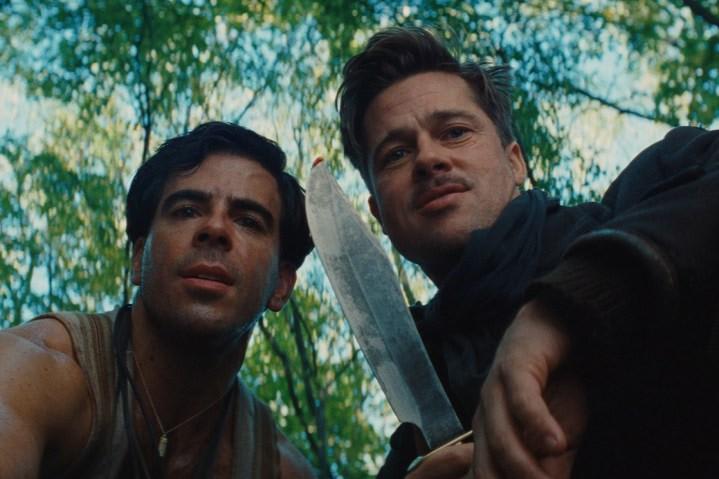Quentin Tarantino, a cinematic virtuoso, has spent three decades reinvigorating and redefining various film genres. From his humble beginnings as a video store clerk to his current status as a world-renowned filmmaker, Tarantino has consistently showcased his unwavering passion for stylized and eccentric cinema. Throughout his illustrious career, he has masterfully reimagined the gangster, crime, samurai, revenge, slasher, Western, and bounty hunter genres. Following the success of genre-defying hits like Reservoir Dogs, Kill Bill, Pulp Fiction, and Jackie Brown, it was only natural that Tarantino would venture into the realm of World War II thrillers, drawing inspiration from classics like The Dirty Dozen, The Great Escape, and The Guns of Navarone. However, few could have predicted the profound impact he would have on the traditional Hollywood war epic.
The resulting film, 2009’s Inglourious Basterds, is a richly woven tapestry of references and homages to a diverse array of 20th-century thrillers, both revered and obscure. This singular masterpiece exudes Tarantino’s signature style, characterized by sleek sophistication and unbridled energy. The film’s confidence is palpable, particularly in its stunning finale, where Tarantino boldly rewrites history, ensuring that Inglourious Basterds remains an unparalleled and irreproducible cinematic achievement. Fifteen years later, no film has managed to replicate this feat.
A Cinematic Masterstroke
Inglourious Basterds is quintessentially structured into multiple chapters, a hallmark of Tarantino’s distinctive storytelling style. The film’s prologue, arguably the most exceptional scene of Tarantino’s career, introduces a Nazi SS Officer named Hans Landa (Christoph Waltz) as he interrogates a French farmer (Denis Ménochet) about the whereabouts of a formerly local Jewish family. As Landa poses his questions, the viewer becomes increasingly aware, through the Nazi’s pointed inquiries and Tarantino’s masterful use of cuts and camera pans, that the Jewish family in question is hiding in the crawlspace beneath the very room where Landa is conducting his investigation. The scene, as tense as any you’ll ever witness, builds to a crescendo of violence that is remarkable not only for its unflinching tragedy but also for the distinctly un-Tarantino-like fact that the blood spilled by Landa’s soldiers is only ever depicted on the face of the Jewish family’s sole survivor, a traumatized Shosanna Dreyfus (an astonishingly talented Mélanie Laurent).
In a later chapter, a clandestine 20-minute tryst between a celebrated German actress secretly working to undermine the Nazi regime (Diane Kruger) and a group of covert Allied operatives is derailed by a cultural gaffe that showcases Tarantino's exceptional prowess in extracting the most from the minutest of details. In another sequence, a dinner meeting between Shosanna and Fredrick Zoller (Daniel Brühl), a Nazi soldier smitten with her, transforms into a harrowing, heart-wrenching ordeal for her as she confronts some of the men most responsible for her people's suffering. The scene, in a stunning and heart-rending subversion of expectations, culminates not with another Tarantino-esque explosion of violence but with a small, uncontrollable emotional outburst from Laurent.
Deliberate destruction

In all of these scenes, Tarantino commits not a single misstep. They are paced, edited, and blocked with precision — as aesthetically stunning as they are technically flawless and economical. There is not a single wasted shot to be found in Inglourious Basterds, and Tarantino appears perpetually fascinated throughout the film in toying with his audience and testing just how long he can stretch each scene before it reaches its breaking point. Were he any other filmmaker, such blatant manipulations and instances of creative indulgence would be grating.
However, he composes every scene so masterfully that the ungodly length of some only heightens the growing sense of foreboding present in each, making it all the more bone-chilling and unbearable. The film quickly becomes a succession of slow-burn scenes that follow the same satisfying, gripping cycle of tension and release. Rather than becoming repetitive, though, Inglourious Basterds becomes a symphony of unspoken danger and potential violence. While he may have a bloodthirsty reputation, Tarantino exercises restraint in his deployment of carnage here.
There are few movies that are as masterfully structured and replete with remarkable scenes as Inglourious Basterds. The film’s sequences serve a greater purpose, though, than just the in-the-moment entertainment factor they provide. Altogether, they gradually ratchet up viewers’ nerves to a frenzied pitch and — even more powerfully — instill a sense of overarching dread in the pit of your stomach. The film’s two most effective and memorable sequences — its opening interrogation and midpoint rendezvous-gone-wrong — end in bloody disaster for the heroes involved. That fact, coupled with viewers’ knowledge of how World War II really ended (i.e., with Hitler ultimately escaping justice by killing himself), forces Inglourious Basterds‘ audience members to prepare themselves to see its heroes’ plans end in disaster. The movie’s climactic chapter, which follows Shosanna and the members of Inglourious Basterds‘ eponymous group as they try to kill Hitler and all the heads of the Third Reich at a film premiere, is packed with nerve-shredding tension for this very reason.
History rewritten
As the untimely demise of Laurent's Shoshanna and Kruger's Bridget Von Hammersmark unfolds, followed by the capture of two self-proclaimed Basterds by Waltz's Hans, a sense of hopelessness begins to settle in. It's almost inevitable that you'll assume Landa, Hitler, and the rest of the Nazi regime will emerge victorious. But Tarantino has other plans. Instead, Landa brokers a deal, Shoshanna's theater is reduced to ashes, and the remaining Basterds manage to riddle Hitler's private viewing balcony with bullets. Tarantino literally disintegrates Hitler on screen, as the righteous fury of Shoshanna's people rages in the periphery of the frame. Tarantino, once again, finds a way to put his own spin on a familiar tale and still operate on his own terms. He rewrites history, providing the ultimate catharsis to the 140 minutes of preceding tension. It's a conclusion that cleverly subverts viewers' expectations, leveraging their knowledge of the film's setting and time period against them. In other words, it's the ending that no one could have anticipated.
In the years since Inglourious Basterds was released, Tarantino has consistently demonstrated his willingness to defy historical accuracy on screen. In 2015's The Hateful Eight, he even finds a way to both satirize and justify his tendency to do so. Of all the many, many surprises that Tarantino has sprung over the past 32 years, though, few have packed quite as much visceral impact as Inglourious Basterds‘ last-minute deviation from recorded history. It only grows more impressive with each passing year, too, especially as Basterds‘ reputation continues to soar. It's a creative decision that speaks to Tarantino's singular genius. Here is a filmmaker who has spent his entire career drawing inspiration from the movies and genres he loves, but what sets him apart from so many other, lesser cinematic imitators is his ability to always know when and how to push the boundaries just a little bit further than they've ever gone before.
In Inglourious Basterds, he got to craft his own WWII thriller, but he didn’t stop there. He decided to give it the ending that so many others felt too constrained by real-life history to attempt, and the finished film is one that manages to feel singular even in an incredibly crowded genre. In the film’s final scene, Tarantino remarks (through Brad Pitt’s Aldo Raine) that Inglourious Basterds “might just be my masterpiece.” The jury’s still out on that, but there’s no denying that it is — at the very least — a masterpiece, one of unparalleled ingenuity, power, and style. It’s a Quentin Tarantino film through and through, and it wears that title with pride, rivaling almost all the rest.
The critically acclaimed Inglourious Basterds is now available for rental on all leading digital platforms.






















